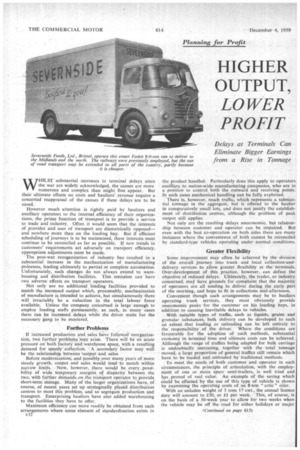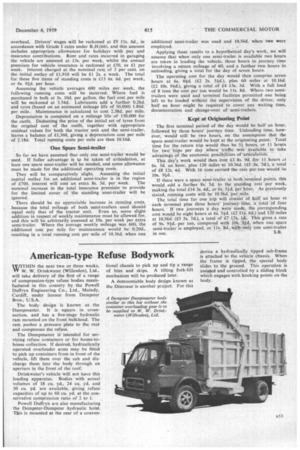HIGHER OUTPUT, LOWER PROFIT
Page 76

Page 83

If you've noticed an error in this article please click here to report it so we can fix it.
HILST substantial increase's in terminal delays since the war are widely acknowledged, the causes are more numerous and complex than might first appear. But their ultimate effects on costs and hauliers' revenue require a concerted reappraisal of the causes if these delays are to be eased.
However much attention is rightly paid by hauliers and ancillary operators to the internal efficiency of their organizations, the prime function of transport is to provide a service to trade and industry. Often it would seem that the interests of provider and user of transport are diametrically opposed— and nowhere more than on the loading bay. But if efficient scheduling of journeys is to be maintained, these interests must continue to be reconciled as far as possible. If new trends in customers' requirements act adversely on transport efficiency, appropriate adjustments must be made.
The post-war reorganization of industry has resulted in a substantial increase in the mechanization of manufacturing processes, leading Ultimately to partial or complete automation. Unfortunately, such changes do not always extend to warehousing and distribution facilities. This omission can have two adverse effects on transport. operators.
Not only are no additional loading facilities provided to match the increased output which, presumably, mechanization of manufacture is intended to achieve, but simultaneously there will invariably be a reduction in the total labour force available. Unless the company concerned, is large enough to employ loading staffs permanently,as . such, in many cases there can be increased delay i while the driver waits for the necessary gang to be mustered.
• Further Problems If increased production and sales have followed reorganizatient, two further problems may arise. There will be an acute pressure on'hOth.factory–and warehouse space, with a resulting demand for speedy "Collection; --A -secondary' factor may well be the relationship between 'output.: and sales.
Before modernization; .and 'possibly over many years of more steady growth, output and sales would tendto match• within narrow limits., r Now, however, there would be every, ,possibility of wide temporary margins of disparity between the two, with further demands on .the transport operator to provide. short-term'storage. Many of the larger organizations have, of course, of recent years set up strategically placed distribution centres to meet this problem, and so segregate production and transport. Enterprising hauliers have also added warehousing to the facilities they have to offer.
Maximum efficiency can more readily be obtained from such arrangements where some element of standardization exists in a32 the product handled. Particularly does this apply to operators ancillary to nation-wide manufacturing companies, who are in a position to control both the outward and receiving points. In such cases mechanical handling can be fully exploited.
There is, however, much traffic, which represents a substantial tonnage in the aggregate, but is offered to the haulier in comparatively small lots, and does not justify the establishment of distribution centres, although the problem of peak output still applies.
Not only are the resulting delays uneconomic, but relationship between customer and operator can be impaired. But even with the best co.-operation on both sides there are many instances where the convenience of both cannot be reconciled by standard-type vehicles operating under normal conditions.
Greater flexibility
Some improvement may often be achieved by the division of the overall journey into trunk and local collection-anddelivery services to allow greater flexibility at the terminals. Over-development of this practice, however, can defeat the objective of reduced delays. Ultimately, the trader, or industry concerned, ma' have grounds for complaint that the majority of operators are all tending to deliver during the early part of the morning, and hope to fit in collections mid-afternoon.
Convenient though such arrangements may be to hauliers operating trunk services, they must obviously provide uneconomic peaks for the customer on his loading bays, in addition to causing inevitable delays to vehicles.
With suitable types of traffic, such as liquids, grains and granular substances, bulk delivery can be developed to such an .extent that loading or unloading can be left entirely to the responsibility ,of the driver. Where the conditions are favourable for the adoption of such methods, substantial economy in terminal time and ultimate costs can be achieved. Although the range of traffics being adapted for bulk carriage is undoubtedly increasing, together -with the total tonnage moved, a large proportion of general traffics still remain which have to be loaded and unloaded by traditional methods.
To meet the' needs of both customer and operator in such circumstances, the principle of articulation, with the employment of one or more spare semi-trailers, is well tried and has proved of .real value. An example of the saving which could be effected by the use of this type of vehicle is shown by examining the operating costs of an 8-ton " artic " oiler.
With an unladen weight of 3 tops 17 cwt., the annual licence duty will amount to £50, or £1 per week. This, of course, is on the basis of a 50-week year to allow for two weeks when the vehicle may be off the road for either holidays or major overhaul. Drivers' wages will be reckoned at £9 I is. 6d., in accordance with Grade I rates under R.H.(66). and this amount includes appropriate allowances for holidays with pay and insurance contributions. Rent arid rates incurred in garaging the vehicle are assessed at 13s. per week, whilst the annual premium for vehicle insurance is reckoned at £50, or £1 per week. Interest charged at the nominal rate of 3 per cent. on the initial outlay of £1,910 will be £1 2s. a week. The total for these five items of standing costs is £13 6s. 6d. per week, or 6s. Old. per hour.
Assuming the vehicle averages 600 miles per week, the following running costs will be incurred: Where fuel is purchased in bulk at 3s, 10d. per gallon, the fuel cost per mile will be reckoned at 3.54d. Lubricants add a further 0.26d. and tyres (based on an estimated mileage life of 30,000) 1.80d. per mile. Maintenance is calculated to cost 2.38d. per mile.
Depreciation is computed on a mileage life of 150,000 for the outfit. Deducting the price of the initial set of tyres from the original cost of the outfit, together with appropriate residual values for both the tractor unit and the semi-trailer. leaves a balance of £1,360, giving a depreciation cost per mile of 2.18d. Total running costs per mile are thus 10.16d.
• One Spare Semi-trailer
So far we have assumed that only one semi-trailer would be used. If fuller advantage is to be taken of articulation, at least one spare semi-trailer will be needed, and some allowance must be made for the additional operating costs.
They will be comparatively slight. Assuming the initial capital outlay for an additional semi-trailer is in the region of £700, interest will cost an extra 8s. 5d. per week, The nominal increase in the total insurance premium to provide for the limited cover of the standing semi-trailer will be .ignored.
There should be no appreciable increase in running costs. _because the total mileage of both semi-trailers used should equal only that of the tractor unit. Even so, some slight addition in respect of weekly maintenance must be allowed for, and this will be arbitrarily assessed at 10s. per week per extra semi-trailer. Where the average weekly mileage was 600, the additional cost per mile for maintenance would be 0.20d., resulting in a total running cost per mile of 10.36d. when one additional semi-trailer was used and 10.56d. when two were employed. .
Applying these results to a hypothetical day's work, we will assume that when only one semi-trailer is available two hours are taken in loading the vehicle, three hours in journey time involving a return mileage of 60, and a further two hours in unloading, giving a total for the day of seven hours.
The operating cost for the day would then comprise seven• hours at 6s. Old. (V 2s. 51-d.). plus 60 miles at 10.16d. (£2 10s. 9+d.), giving a total of £4 .13s. 3d. With a full load of 8 tons the cost per ton would be lls. 8d. Where two semitrailers were used and terminal facilities permitted one being left to be loaded without the supervision of the driver, only half an hour might be required to cover any waiting time, documentation and change-over of semi-trailers.
Kept at Originating Point The first terminal period of the day would be half an hour. followed by three hours' journey time. Unloading time, however, would still be two hours, on the assumption that the spare semi-trailer would be kept at the originating point. Total time for the return trip would thus be 51 hours, or 11 hours for two trips per day where.' traffic was available to take advantage of the economic possibilitiesof 'articulation:
This day's work would then cost £3. 8s. 9d. „for 11 hours at 6s. 3d. an hour, plus 120 miles at 10.36d. (£5 3s. 7d:)',. a total of 18 12s. 4d. With 16 tons carried the Crate per ton would be 10s. 91d.
If there were a spare semi-trailer at both terminal points, this would add a further 8s. 5d. to the standing cost -per week, making the total £14 3s. 4d., or 6s. 51d per hour. As previously stated, running costs will be 10.56d.lper mile.
The total time for one trip will consist of half an hour at each terminal plus three 'hours' journey time, a total of four hours. If 'two journeys a' day were made, the corresponding cost would be eight hours at 6s. 51c1. (12 6d.) and 120 miles at 10.56d. (£5 5s. 7d.), a total of £7 17s. ld: This gives a rate of 95. 91d. per ton, compared with Ws. 91d. when one spare semi-trailer is employed, or lls. 8d. with only one semi-trailer in use. S.B.
























































































































